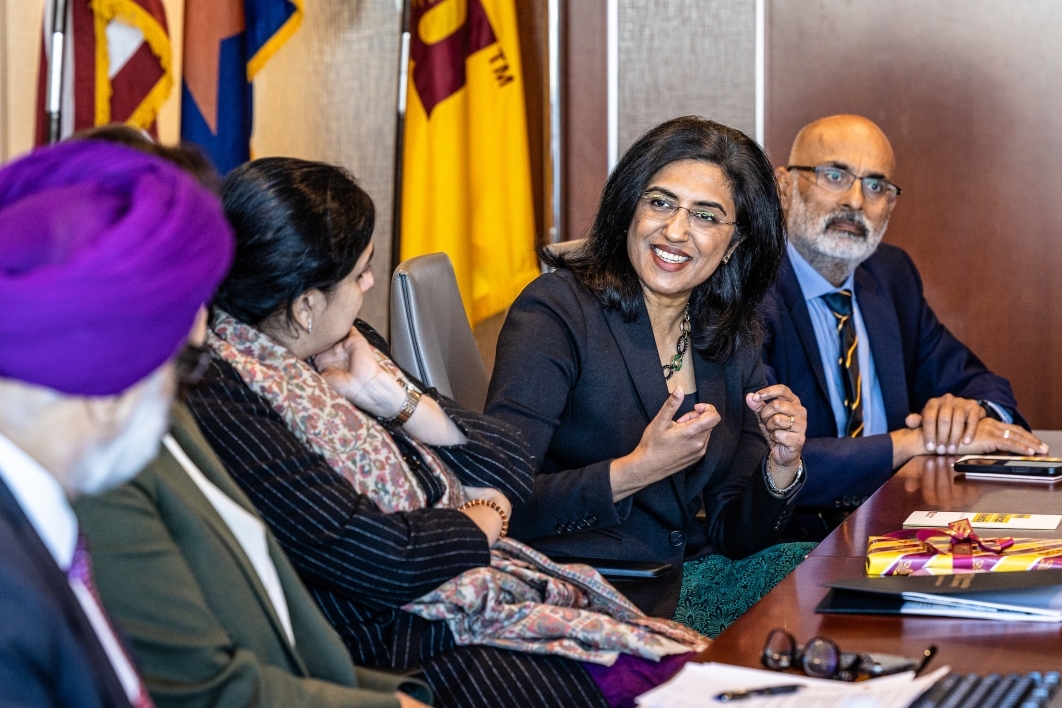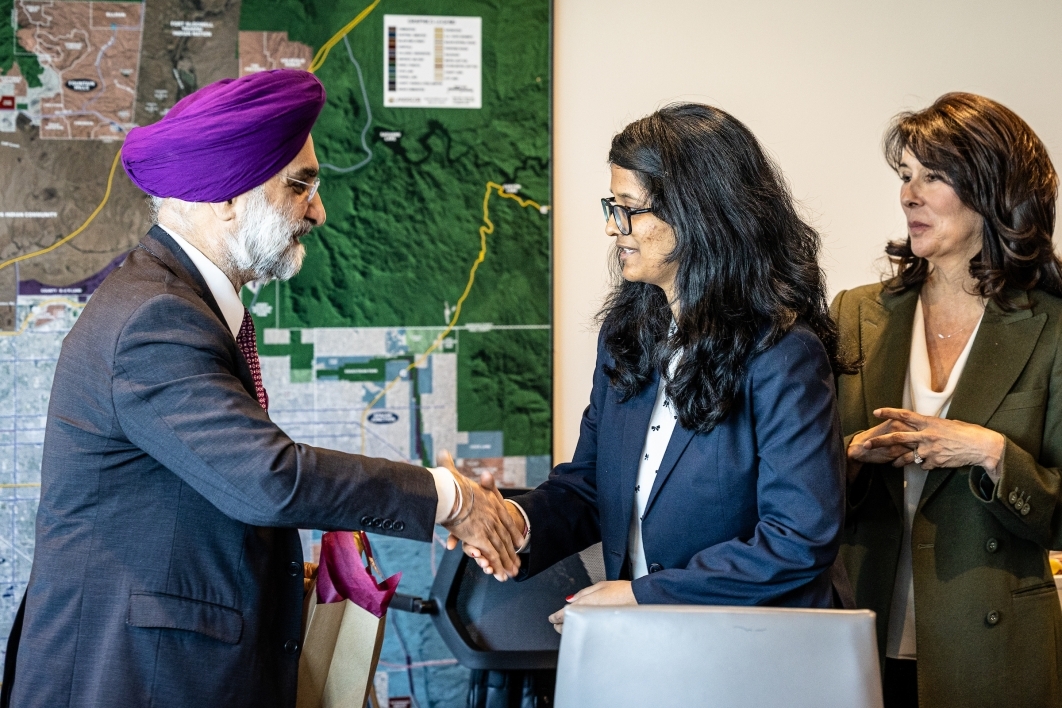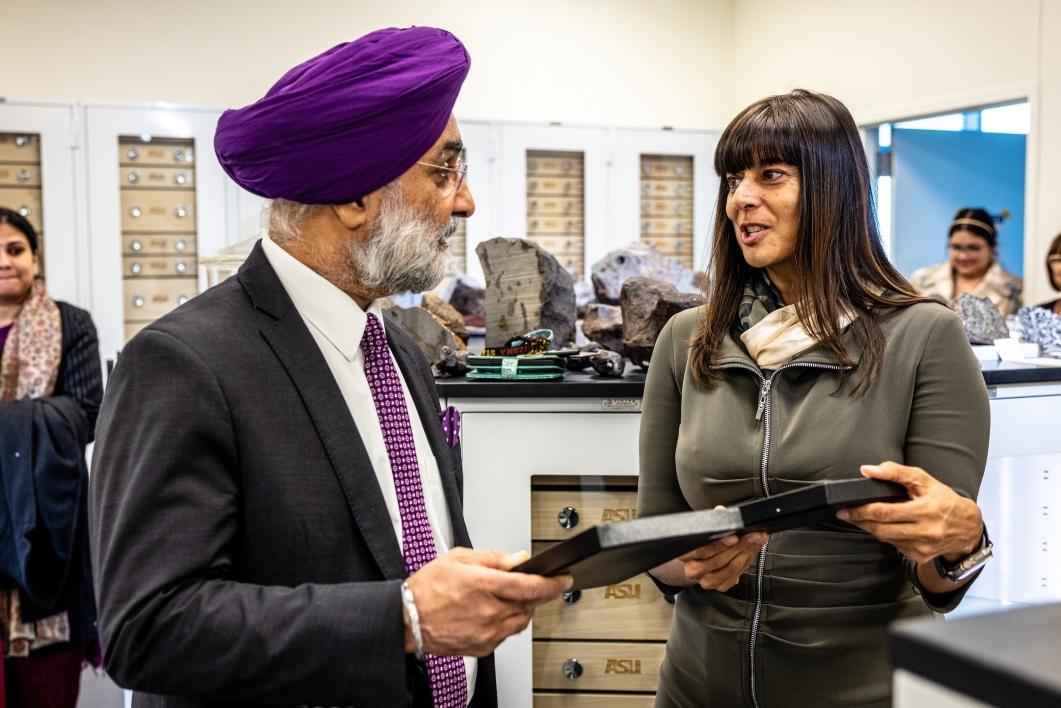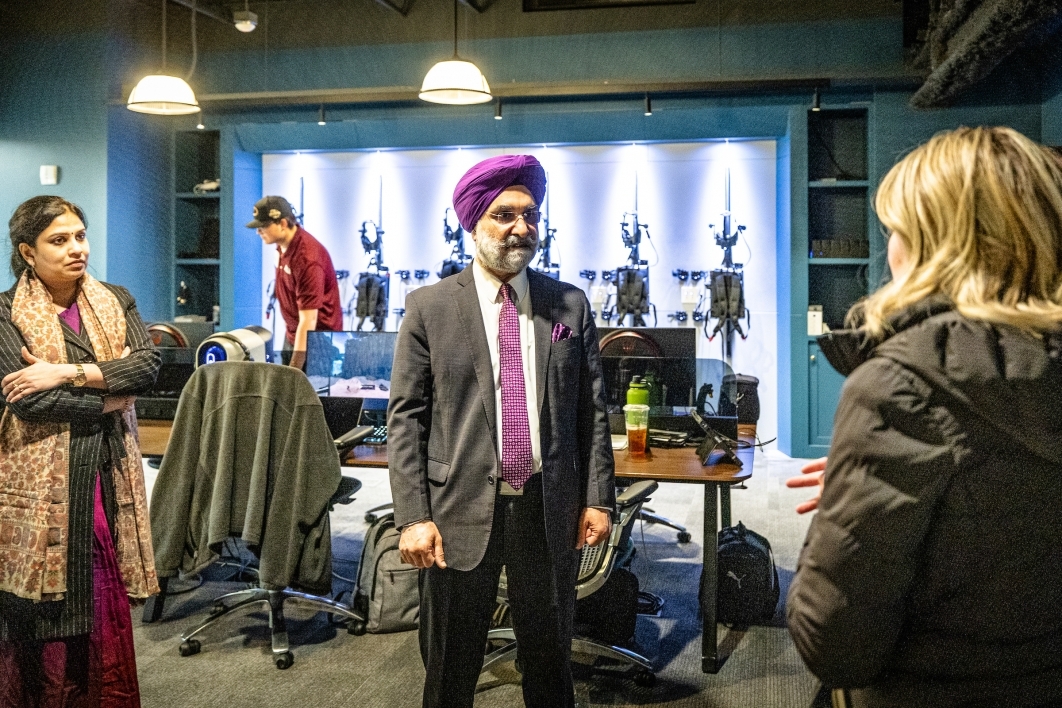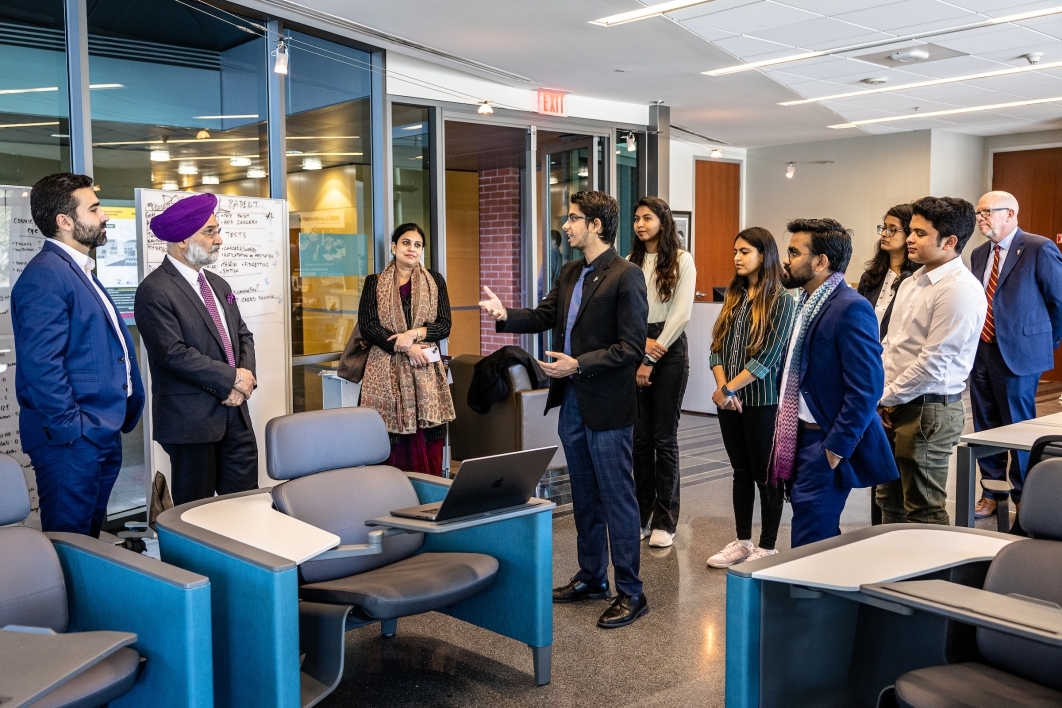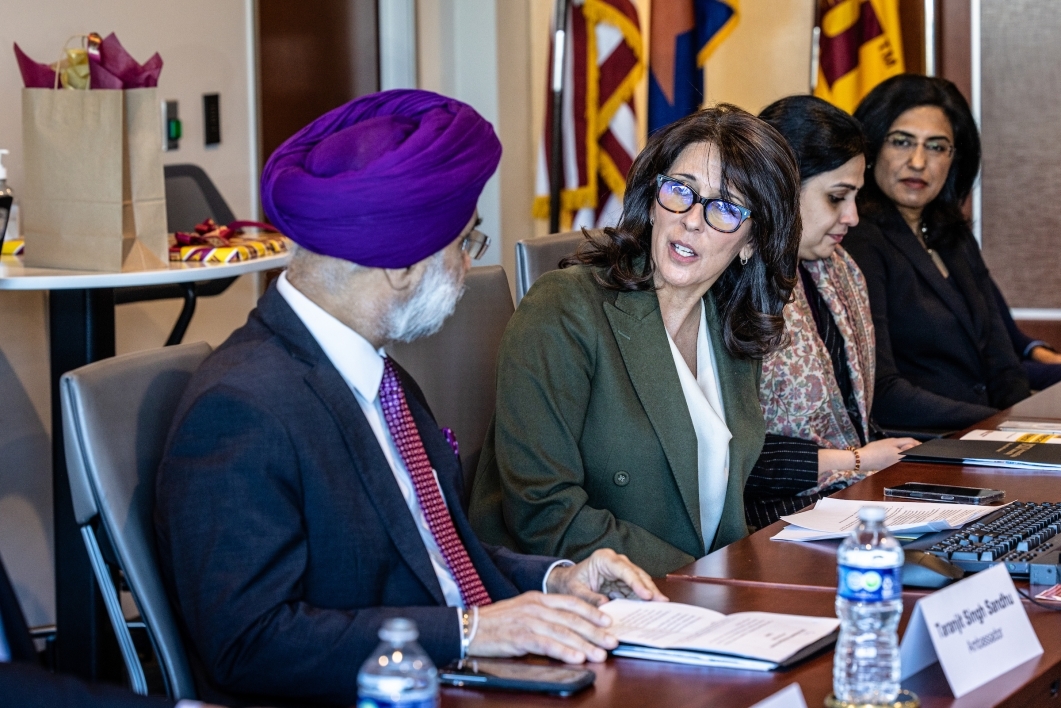India ambassador visits with students, faculty to learn about ASU innovations
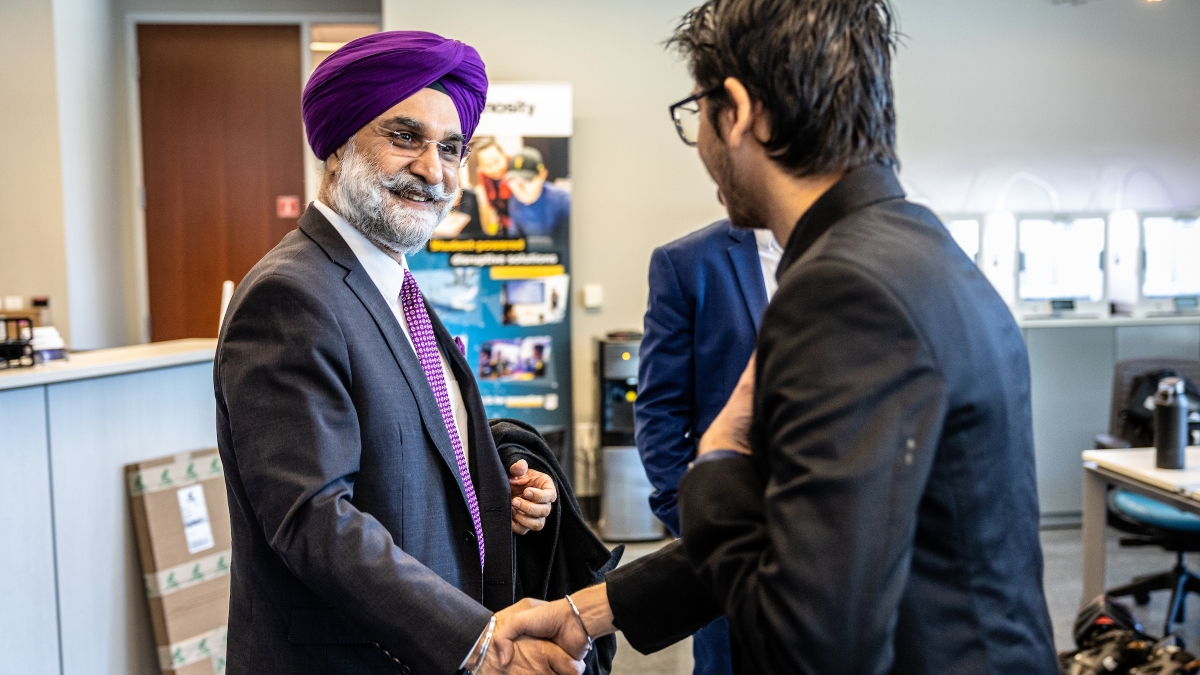
As the United States and India pledge to expand cooperation and technology partnerships between the two nations, an important figure in India recently received an up-close look at innovation at Arizona State University.
Taranjit Singh Sandhu, ambassador of India to the United States, met with top university leaders and toured key campus spots to learn about the latest in laser research, integrating virtual reality into classroom learning and ASU’s work to explore space.
With the largest university enrollment of degree-seeking students from India in the U.S., ASU is a critical partner in advancing knowledge and developing the workforce that will be needed as the two countries deepen their strategic collaborations.
“In my tour of some of the cutting-edge facilities at ASU, as well as interaction with President Michael Crow and senior faculty, I could sense the confluence of access and excellence in education and innovation at the university,” Sandhu said. “It was also heartening to see the substantial presence of Indian students and faculty in key disciplines. I look forward to working with President Crow and team to strengthen the existing linkages that ASU has with India and explore new opportunities, especially those opened up by policy initiatives in India.”
The ambassador’s visit underscores the importance of the U.S.-India initiative on Critical and Emerging Technology (iCET), which was announced last year. The goal is to elevate and expand partnerships between the two governments, businesses and academic institutions.
Of particular interest are innovation, space, semiconductor supply chains, defense innovation and technology, next-generation telecommunications, and science, engineering and math talent.
The ambassador’s interest in ASU also reflects the university’s deep commitment to global engagement. Consider:
• The influential 2022 Institute of International Education Open Doors Report listed ASU as the top public university in the U.S. for hosting international students, with more than 15,000 international students from 158 countries joining ASU in the 2021–22 academic year.
• That same year, the Times Higher Education ranked ASU No. 2 in the world for global impact.
• With more than 6,600 students from India enrolled in fall 2022, ASU is the top university home in the U.S. for students from India, ahead of the University of Texas, University of Illinois, New York University, Purdue and the Georgia Institute of Technology.
• More than 13,500 Indian students have participated in Optional Practical Training (OPT) since 2017, landing career relevant experience at leading U.S. corporations including Amazon, Intel, Microsoft, Google and Tesla, among others.
• ASU’s Indian alumni network exceeds 12,600 alumni, with more than 7,000 graduating in the past decade.
• ASU already has 11 academic partnerships with universities in India.
On his tour, Sandhu experienced highlights of ASU’s multidisciplinary excellence and student- and faculty-driven innovations.
He met with the director and students in the Luminosity Lab to learn about their city simulator project aimed at assisting policy makers in making data-driven decisions about Arizona's future. He toured the Biodesign Institute, learning about research into vaccines — including the key role of an Indian professor, Vel Murugan, at ASU that contributed to the university’s saliva-based COVID-19 test. He also received a first-hand look at a new compact X-ray light source (CXLS) instrument that will help scientists see deeper into matter and living things.
Over at the School of Earth and Space Exploration, Director Meenakshi Wadhwa discussed the interdisciplinary approach and strengths in combining science and engineering. She showed the ambassador the school’s capabilities, labs and resources for space exploration, including the mission operations area and high bay facilities for instrument and spacecraft assembly and testing. Students and faculty highlighted a six-legged rover, designed for NASA and developed to traverse the moon’s steep craters on scientific missions.
The ambassador then learned about Dreamscape Learn and how ASU’s immersive storytelling using virtual reality transforms the classroom experience.
Leaders from across the university, convened by Executive Vice President and University Provost Nancy Gonzales, joined the ambassador for an afternoon discussion on the mutual academic objectives of India and the United States. Academic leaders from colleges with large Indian student enrollments were present, including the Ira. A Fulton Schools of Engineering, The College of Liberal Arts and Sciences, Thunderbird School of Global Management and the W. P. Carey School of Business.
Among the leaders in attendance was Minu Ipe, managing director and vice chair of ASU’s University Design Institute.
“It was inspiring to hear Ambassador Sandhu share India’s vision and initiatives in high-tech and education," Ipe said. "We are excited to explore collaborative opportunities through India's new National Education Policy."
Sandhu closed his visit with a meeting with ASU President Michael Crow to discuss philosophies on access and excellence, expanding access to higher education in India, and the growing partnership between the two countries. Commerce and education Minister Suja K. Menon and Stephen Mani, the first secretary to Ambassador Sandhu, joined the discussions.
“Arizona State University is proud to be a top choice for learners from India and an ally in innovation with Indian partners,” Crow said. “It was an honor to share examples of our institutional commitment with Ambassador Sandhu and to delve into how we may work to build on our shared interests. We are excited to explore those prospects together.”
Some of ASU’s Indian students were able to meet the ambassador during his two-day tour, including Yashaswini Karanth, president of the Indian Student Association and a PhD candidate in material sciences.
“My interaction with Ambassador Sandhu was an insightful and impactful experience,” Karanth said. “Being in the presence of someone who was so grounded and had such a clear vision for the future was inspiring. He posed articulate questions regarding ASU’s endeavors at unifying excellency and accessibility.”
A particularly meaningful moment of the visit came when Karanth presented the ambassador with a bronze bell by Paolo Soleri, the famed Arizona artist and architect who dedicated his work to the advancement of sustainability. When presenting the gift, Karanth knelt to touch the ambassador’s feet to seek his blessing as she continues her doctoral studies. The gesture, an ancient sign of respect for elders in Indian culture, demonstrated the deep cultural roots that students from India maintain while they live and learn at ASU.
When reflecting on the visit, Karanth added, “The conversation was stimulating, and it was a tremendous honor to be in the room and get to be a small part of the conversation.”
Gonzales said it “was an honor” to host Ambassador Sandhu, Minister Menon and First Secretary Mani.
“From our visit, it was evident that we share the goals of advancing leading-edge technology and knowledge, and expanding access to higher education for learners in India,” she said. “Our community of Indian students, alumni and scholars is robust, and ASU is committed to sharing knowledge and creating an intellectual environment that will enable them to thrive in their lives and careers.”
Top photo: Taranjit Singh Sandhu, the U.S. ambassador from India, greets Luminosity Lab students during his tour of ASU on Thursday, Feb. 16. Photo by Charlie Leight/ASU News
More Science and technology

Hack like you 'meme' it
What do pepperoni pizza, cat memes and an online dojo have in common?It turns out, these are all essential elements of a great cybersecurity hacking competition.And experts at Arizona State…

ASU professor breeds new tomato variety, the 'Desert Dew'
In an era defined by climate volatility and resource scarcity, researchers are developing crops that can survive — and thrive — under pressure.One such innovation is the newly released tomato variety…

Science meets play: ASU researcher makes developmental science hands-on for families
On a Friday morning at the Edna Vihel Arts Center in Tempe, toddlers dip paint brushes into bright colors, decorating paper fish. Nearby, children chase bubbles and move to music, while…


